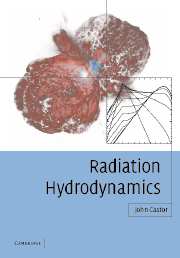Book contents
- Frontmatter
- Contents
- List of figures
- Preface
- 1 Introduction
- 2 A quick review of gas dynamics
- 3 Numerical hydrodynamics
- 4 Description of radiation
- 5 Steady-state transfer
- 6 The comoving-frame picture
- 7 Hydrodynamics with radiation: waves and stability
- 8 Radiation–matter interactions
- 9 Spectral line transport
- 10 Refraction and polarized light
- 11 Numerical techniques for radiation transport
- 12 Examples
- References
- Index
9 - Spectral line transport
Published online by Cambridge University Press: 18 February 2010
- Frontmatter
- Contents
- List of figures
- Preface
- 1 Introduction
- 2 A quick review of gas dynamics
- 3 Numerical hydrodynamics
- 4 Description of radiation
- 5 Steady-state transfer
- 6 The comoving-frame picture
- 7 Hydrodynamics with radiation: waves and stability
- 8 Radiation–matter interactions
- 9 Spectral line transport
- 10 Refraction and polarized light
- 11 Numerical techniques for radiation transport
- 12 Examples
- References
- Index
Summary
Non-LTE
The title non-LTE refers to a method for analyzing the interaction between a gas and the radiation field that accounts for the modification of the excitation and ionization state of the atoms in the gas by the influence of the radiation field. If the radiation field is weak or the density is large, then the occupation probabilities of the atomic states are governed by the dominant collisional processes. In a wide variety of cases the rates of electron–electron and ion–ion collisions, and usually electron–ion collisions as well, are so great that the relaxation of all these species to a single kinetic temperature is essentially complete. So when collisional processes dominate the atomic excitation rates, the result is occupation probabilities that agree with thermodynamic equilibrium, no matter what the radiation intensities may be. This is LTE – local thermodynamic equilibrium. So non-LTE is the other situation. In non-LTE the relaxation of the velocity distributions of the electrons and atoms to a single kinetic temperature is still supposed to be true. But what is not true in non-LTE is that collisional processes are generally dominant over the competing radiative processes for populating and depopulating the atomic states.
Non-LTE is a large subject. Good references for non-LTE line transport are Mihalas's Stellar Atmospheres (1978), Athay (1972b) and Ivanov (1973). Approximations to the electron-impact excitation rate are discussed by Sobel'man (1979) and by Sampson and Zhang (1992, 1996).
Kinetic equations
As a system for doing calculations, non-LTE consists of solving for the radiation field Iv and the set of atomic occupations Nij, also often called the “populations.” Here i is an index for elements, and j is an index for an energy level belonging to that element.
- Type
- Chapter
- Information
- Radiation Hydrodynamics , pp. 179 - 211Publisher: Cambridge University PressPrint publication year: 2004



